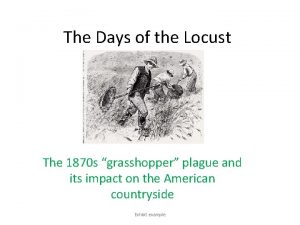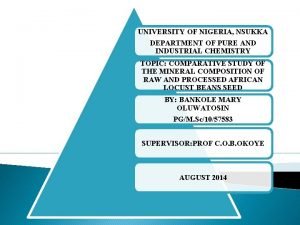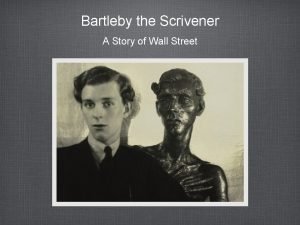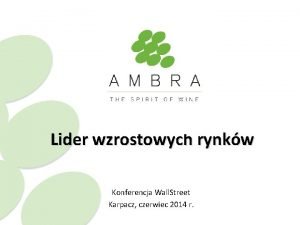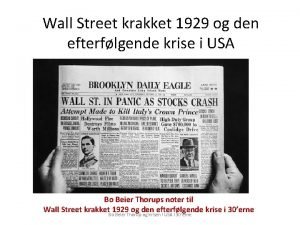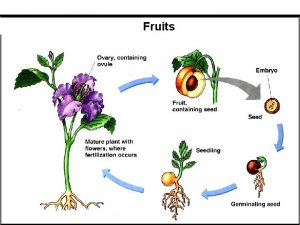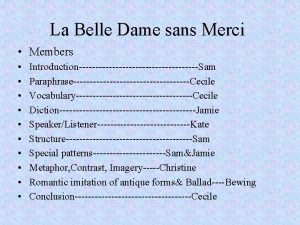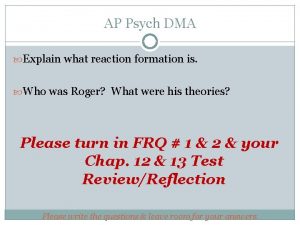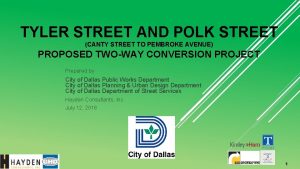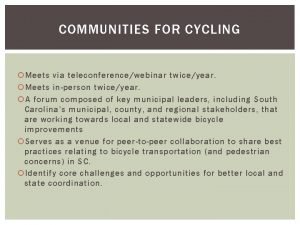Wall Street Meets Locust Walk The PennLehman Automated



























- Slides: 27

Wall Street Meets Locust Walk: The Penn-Lehman Automated Trading Project Michael Kearns Computer and Information Science University of Pennsylvania

Economics and Computation • Electronic Commerce • Algorithmic Mechanism Design • Network Economics • Digital Goods • Shopbots • Computational Game Theory • Combinatorial Auctions • Information Markets • Electronic Cheating • Neuroeconomics Theory, Algorithms… and Competitions

Meanwhile, in the Real World… • Increased automation in financial markets (exchanges, program trading, tools, strategies) • Technological, business and regulatory drivers (decimalization, ECNs) • Increased revelation of market data We’re not going back.

Motivation • Can we somehow merge – the realism, speed and excitement of trading in real securities markets – the exploratory, educational and creative nature of trading in virtual markets

The Penn-Lehman Automated Trading (PLAT) Project • Real-time, automated trading in financial markets • A realistic, multi-client market simulator using live and historical depth-of-market data • A competitive testbed for trading strategies • An investigation of order book strategies • An investigation of AI and machine learning methods for automated trading • A research and educational partnership between Penn and Lehman Brothers

Market Microstructure and Depth-of-Market • • Consider a typical exchange for some specific security Market order: give volume, leave price to “the market” Limit order: specify price (away from the market) Limit orders are placed in a book on the buy or sell side, ordered by price • Market orders are matched with the top of the book on the opposing side • Market orders “guaranteed” transaction but not price; limit orders guaranteed price but not transaction Here’s an example.

Electronic Crossing Networks (ECNs) • Matching process as old as securities markets • Often done manually (NYSE specialists) • Electronic Crossing Networks (ECNs): – Automate matching process – Now publishing order book data – Can be highly liquid • Examples: Island (14% of NASDAQ volume), Instinet, Archipelago, … • Consolidation efforts (Super. Montage) • Messaging protocols, APIs (OUCH and ITCH)

The Penn Exchange Simulator (PXS) • A (conceptually) simple, real-time market simulator exploiting order book data • Core processes: – Data Gathering: frequent (live or historical) polling of any given stock from Island – Client Order Processing: acceptance of connections and limit orders from automated clients via API – Market Simulation: simulation of matching process in a virtual market merging the Island client data; computation of profit and loss of clients

PXS Client 1 BUY SELL 24. 0640 24. 0670 24. 0630 24. 0690 24. 0620 24. 0690 24. 0610 24. 0700 24. 0605 24. 0750 24. 0600 24. 0800 24. 0600 24. 0900 24. 0550 24. 0900 24. 0530 24. 0980 24. 0500 24. 0990 Client 2 Client 3

Features of PXS • • Simulation merges real market with client orders No guesses or models for limit order fills Permits investigation of order-book strategies Permits high-speed, high volume trading Forces real-time performance Sandbox for diverse strategies & interaction Execute “live” on real-time data or historical

PLAT Project Participants • Penn Development Team: – – PXS design, development, maintenance Client strategy design Education of student researchers/users Competition design and execution • Students: – Approximately 30 students designing 14 strategies – Many senior projects; many joint CIS-Wharton – Several external participants (UTexas and CMU) • Lehman Brothers: – Financial support from Proprietary Trading Group – Student mentorship and competition judging – Technological and scientific advising

Goals for the Strategies and Competitions • Attempt to recreate Wall Street “biodiversity” • Market making, pairs trading, VWAP, block trading, technical strategies, etc. • Investigate predictive value of order book data • Investigate application of AI and ML methods • Create a library of strategies and competition structures for mix and match experimentation

The Competitions • • All had +/- 100, 00 share position limits All on MSFT trading All divided clients into two pools December 2002: historical and live data competition Order-book face-off March 2003: 3 -round, 3 -week competition May 2003: – – Platinum Platter Competition (PPC 2003) 10 consecutive days of MSFT trading, no rounds 6 scoring criteria balancing profitability and trading “hygiene” Counted towards grades

PPC 2003: The Rules

PPC 2003: The Strategies

Strategy Themes • Order-book strategies – order book imbalance and variations – 9 of 14 competition entrants • Market-making strategies • Traditional technical strategies: – various “breakout” strategies, trend spotting, etc. – often with order-book modulation • Machine learning strategies using order books – boosting, case-based learning, support vectors

PPC 2003: The Results

Global Analysis

Total Volume Executed

Price and Inside Markets vs. Island Red Pool Blue Pool (PXS – Island)

Client Analysis

300 K 600 K 1. 5 M 6 M 300 K 150 K 140 K Blue Pool Client Share Positions

1. 7 M 500 K 700 K 60 K 2 M 400 K 150 K Red Pool Client Share Positions

The Simple. Trend Debacle

Conclusions • Electronic Commerce is alive and well • Penn-Lehman project: – – exploits advent of order book data mixes the real and virtual educates in a friendly but competitive environment has produced a couple of promising strategy ideas

Collaborators • Penn: – – – Luis Ortiz Berk Kapicioglu Byoungjoon Kim Rashid Tuweiq Elliot Feng • Lehman Brothers: – – – – Andy Ellner Mark Sanborn Colin Rust Amy Papandreou Michael Schulman Michael Bos Michael Bleich

Further Information • Email: mkearns@cis. upenn. edu • Web sites: – www. cis. upenn. edu/~mkearns/projects/plat. html – www. cis. upenn. edu/~mkearns/papers/plat. pdf (joint paper on the project with Luis Ortiz) • New participants welcome!
 With whom do booth and herold stay at locust hill farm?
With whom do booth and herold stay at locust hill farm? Wildcat
Wildcat 1870 locust plague
1870 locust plague Locust
Locust How does okonkwo act for two days after ikemefuna's death
How does okonkwo act for two days after ikemefuna's death Peter locust pedagogia
Peter locust pedagogia Bartleby, the scrivener: a story of wall-street
Bartleby, the scrivener: a story of wall-street Konferencja wall street
Konferencja wall street Wall street krakket
Wall street krakket During the great depression there were many wanderers
During the great depression there were many wanderers Wall street presentation
Wall street presentation Wall street journal manufacturing
Wall street journal manufacturing Sound walls for reading
Sound walls for reading Wall to wall chris brown
Wall to wall chris brown Members used to carry wall loads over wall openings
Members used to carry wall loads over wall openings Half brick wall
Half brick wall Pod fruit develops from
Pod fruit develops from Science meets nature
Science meets nature Narrow band where the ocean meets land
Narrow band where the ocean meets land Generally restful like the horison where the sky meets land
Generally restful like the horison where the sky meets land Approaches meets masters
Approaches meets masters Academia meets industry
Academia meets industry How does huck feel about not turning jim in
How does huck feel about not turning jim in Approaches meets masters
Approaches meets masters Where tradition meets tomorrow
Where tradition meets tomorrow Where today meets tomorrow
Where today meets tomorrow La belle dame sans merci structure
La belle dame sans merci structure Freud meets mother goose
Freud meets mother goose


